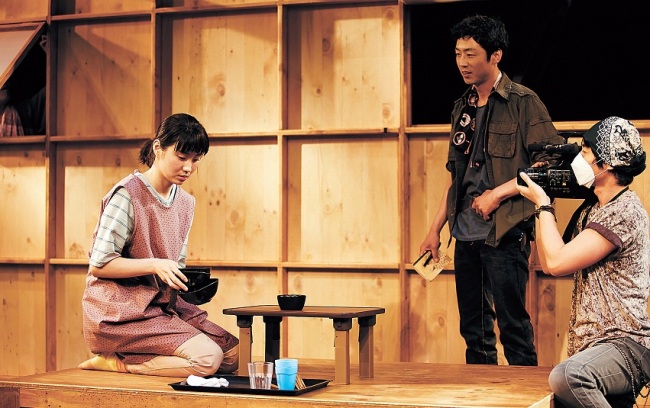When a play transcends the theater
‘Haisui no Koto’ deals with distrust, injustice in aftermath of Fukushima nuclear disaster
By Korea HeraldPublished : June 19, 2014 - 21:00
A Japanese play that evoked sympathy from spectators in Japan by probing the distrust and injustice revealed in the wake of the 2011 tsunami and the resulting Fukushima nuclear disaster will be staged until July 5 at the Doosan Art Center’s Space 111 in Seoul.
“Haisui no Koto (Remote Backwater Island),” which opened last week and is directed by Kim Jae-yeop, is set in the aftermath of the disaster, which claimed over 16,000 lives.
The play was originally written and directed by Tokyo-based Akhito Nakatsuru six months after the accident. It depicts the conflicts arising in the time of crisis within Japan’s state-centered and materialistic society, which often neglects its marginalized members. It also deals with environmental issues.
“Haisui no Koto (Remote Backwater Island),” which opened last week and is directed by Kim Jae-yeop, is set in the aftermath of the disaster, which claimed over 16,000 lives.
The play was originally written and directed by Tokyo-based Akhito Nakatsuru six months after the accident. It depicts the conflicts arising in the time of crisis within Japan’s state-centered and materialistic society, which often neglects its marginalized members. It also deals with environmental issues.

As suggested by the title, which literally means “burning one’s bridges” on an “isolated island,” it is none other than Japan which has to put up a desperate, lonely fight against the horrific disaster, without any place to flee.
The drama contains a warning message for Korea.
“Japan’s nuclear disaster is not just a neighbor’s problem anymore,” Kim, who is also a professor at Sejong University, told The Korea Herald after the play.
“South Korea is vulnerable, with a total of 23 nuclear power plants up and running and five under construction. It will have the world’s highest density of atomic plants by the 2020s.”
The drama begins with a scene at a press club in Tokyo, about 250 km away from the site of the nuclear disaster. Komoto, a reporter for a state-run broadcasting network, is frustrated by the fact that he is barred from revealing the circumstances of the nuclear accident by the Japanese government, which is trying to protect Tokyo Electric Power Co., which is responsible for the plants.
“We are no longer allowed to write what we see and hear,” says Komoto. Dismayed by the limitations of news reporting, he leaves Tokyo for Ishinomaki, a disaster-struck town, to film a documentary about the surviving families.
The drama is divided into two acts.
In the first act, Komoto observes Taiyo’s family around the clock. They live temporarily in a small wooden barn, enduring one day at a time with a limited water supply, seaweed soup and small servings of rice. Fifty days have passed since the accident.
The play describes the aftermath of the nuclear disaster very convincingly.
Taiyo gets in trouble for stealing cans of food from a factory and selling them on the street to eke out a living. The volunteers and families are embroiled in a conflict of interest. Taiyo’s sister quits medical school to support her family after her mother dies in the tsunami.
“This village smells like something is rotten,” Taiyo cries out. “It’s not the odor of a rotting corpse, it is the people’s hearts that are rotting.”
Flies buzz uninterruptedly in the village. The people left behind are irritated, hopeless and, most of all, devastated.
The second act envisions Japan 10 years after the accident. The nuclear issue is still an ongoing problem as the Japanese government seeks to build another nuclear power plant. Unlike the first act, based on the writer’s observations while he volunteered at the site, the second act seems more like a mix of sci-fi and the writer’s imagination.
“While the play deals with the nuclear crisis, the prevailing message goes beyond this issue,” Kim said. “We live in a world where distrust and injustice are prevalent in all parts of society, especially when confronted with national disasters that threaten people’s safety.”
“The earthquake and tsunami was a natural disaster, but the meltdown of the nuclear power plant had some aspects of a man-made disaster,” Kim said. “The disaster could have been foreseen and the damage could have been mitigated by a more effective human response.”
When the play was over, many in the audience left teary-eyed, some connecting the incident with the recent Sewol ferry accident. “We should not forget the victims, whether they are Fukushima victims or Sewol victims. We have to speak out,” a spectator said after the play.
Kim said that Japan’s response and treatment of the victims and how people accepted the tragedy felt real for him and the cast as the Sewol incident unfolded while they were preparing for the play. “There were many similarities,” he said.
“I want to make a play where I can communicate ongoing issues on the stage and share my thoughts with the audience,” said Kim, whose highly acclaimed work “The Alibi Chronicles” portrayed concerns with societal justice through a lone individual.
“It is often the trivial real story of an individual that echoes in people’s hearts.”
“Haisui no Koto,” part of the “2014 Doosan Humanities: The Age of Distrust” series runs from June 10 to July 5 at Doosan Art Center’s Space 111. For more information, visit www.doosanartcenter.com.
By Ahn Sung-mi (sahn@heraldcorp.com)
-
Articles by Korea Herald








![[Graphic News] More Koreans say they plan long-distance trips this year](http://res.heraldm.com/phpwas/restmb_idxmake.php?idx=644&simg=/content/image/2024/04/17/20240417050828_0.gif&u=)
![[KH Explains] Hyundai's full hybrid edge to pay off amid slow transition to pure EVs](http://res.heraldm.com/phpwas/restmb_idxmake.php?idx=644&simg=/content/image/2024/04/18/20240418050645_0.jpg&u=20240419100350)






![[From the Scene] Monks, Buddhists hail return of remains of Buddhas](http://res.heraldm.com/phpwas/restmb_idxmake.php?idx=652&simg=/content/image/2024/04/19/20240419050617_0.jpg&u=20240419175937)

![[KH Explains] Hyundai's full hybrid edge to pay off amid slow transition to pure EVs](http://res.heraldm.com/phpwas/restmb_idxmake.php?idx=652&simg=/content/image/2024/04/18/20240418050645_0.jpg&u=20240419100350)

![[Today’s K-pop] Illit drops debut single remix](http://res.heraldm.com/phpwas/restmb_idxmake.php?idx=642&simg=/content/image/2024/04/19/20240419050612_0.jpg&u=)